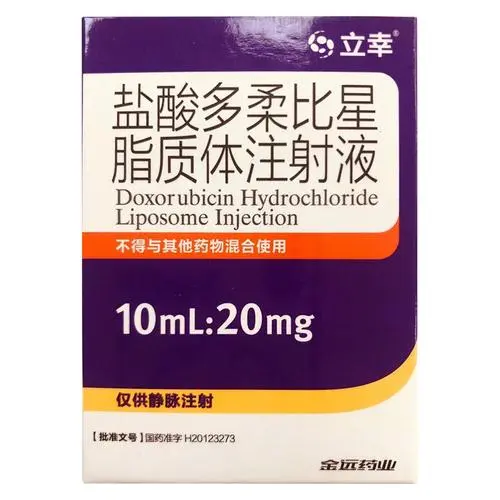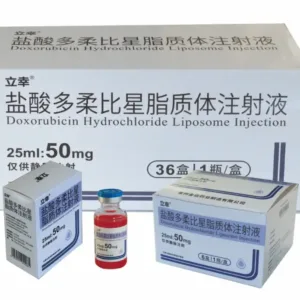Doxorubicin Hydrochloride liposome for Injection.
Functions and indications:
Used for acute leukemia (lymphocytic and granulocytic), malignant lymphoma, breast cancer, lung cancer (small cell and non-small cell lung cancer), ovarian cancer, bone and soft tissue sarcoma, nephroblastoma, neuroblastoma, bladder cancer, thyroid cancer, prostate cancer, head and neck squamous cell carcinoma, testicular cancer, gastric cancer, liver cancer, etc.
Usage and dosage:
The dosage and dosage of this product may vary in different dosage forms and specifications. Please read the specific drug instructions for use, or follow the doctor’s advice. Doxorubicin hydrochloride for injection/doxorubicin hydrochloride injection: intravenous injection, intravenous drip or arterial injection. Dissolve in sterile water for injection before use, the concentration is 2mg/ml. The results of the in vitro hemolytic test of this product show that this product has hemolytic properties. Pay attention to slow injection or slow drip when administering and closely monitor blood counts. 1. The common dosage for adults is 50-60mg/ml, once every 3-4 weeks or 20mg/m2 a day, for 3 consecutive days, and repeat after 2-3 weeks of discontinuation. The combined drug is 40 mg/m2, once every 3 weeks or 25 mg/m2, once a week, for 2 consecutive weeks, and repeated for 3 weeks. The total dose should not exceed 400 mg/m2 based on body weight and area. The myocardial toxicity, bone marrow suppression and gastrointestinal reactions (including oral ulcers) of divided doses are milder than those of once every 3 weeks. 2. Combination chemotherapy: (1) ABVD (doxorubicin, bleomycin, vincristine and dacarbazine), mainly used for Hodgkin’s lymphoma. (2) CAF (cyclophosphamide, doxorubicin and fluorouracil), mainly used for breast cancer. (3) CHOP (cyclophosphamide, doxorubicin, vincristine and prednisone), mainly used for non-Hodgkin’s lymphoma. (4) FAM (fluorouracil, doxorubicin and mitomycin), mainly used for gastric cancer. (5) AC (doxorubicin and cytarabine), mainly used for adult acute myeloid leukemia. (6) AOP (doxorubicin, vincristine and prednisone), mainly used for induction of remission of lymphoblastic acute leukemia. (7) ACP (doxorubicin, cyclophosphamide and cisplatin), mainly used for ovarian cancer, lung cancer, head and neck cancer, bladder cancer, etc. (8) COAD (cyclophosphamide, vincristine, doxorubicin and dacarbazine), mainly used for soft tissue sarcoma and osteosarcoma. (9) CAO (cyclophosphamide, doxorubicin, vincristine) is mainly used for small cell lung cancer. Doxorubicin hydrochloride liposome injection: 1. This product should be administered intravenously at 20 mg/m2 every 2-3 weeks, and the dosing interval should not be less than 10 days, because the possibility of drug accumulation and increased toxicity cannot be ruled out. Patients should continue treatment for 2-3 months to produce therapeutic effects. To maintain a certain therapeutic effect, continue to administer the drug when necessary. This product is diluted with 250 ml of 5% glucose injection and intravenously dripped for more than 30 minutes. Large doses of injection or administration of undiluted solution are prohibited. It is recommended that the drip tube of this product be connected to a 5% glucose drip tube to further dilute and minimize the risk of thrombosis and extravasation. 2. This product is contraindicated for intramuscular and subcutaneous injection. 3. Patients with hepatic insufficiency: For a small number of patients with hepatic insufficiency ( When the bilirubin value reaches 4 mg/dl), 20 mg/m2 of this product is given, and there is no change in plasma clearance rate and elimination half-life. However, before further experience is gained, based on previous experience with the use of doxorubicin hydrochloride, the dosage of this product should be reduced for patients with impaired liver function. It is recommended to consider reducing the dosage when the bilirubin is higher than the following values: serum bilirubin 1.2-3.0 mg/dl, use 1/2 of the usual dose; when it is greater than 3 mg/dl, use 1/4 of the usual dose. 4. Patients with renal insufficiency: Since doxorubicin is metabolized by the liver and excreted through bile, the dose does not need to be adjusted when using this product. 5. Splenectomy patients: There is currently no experience in using this product in splenectomy patients, so it is not recommended. 6. The following precautions should be taken during use and operation: (1) It is forbidden to use equipment with precipitates or other impurities . (2) Determine the dosage of this product based on the recommended dose and the patient’s body surface area. (3) Use a sterile syringe to draw an appropriate amount of this product. (4) Since no preservatives or antibacterial agents are added to this product, aseptic operation must be strictly followed. (5) Before administration, the required amount must be taken out and diluted with 250ml 5% glucose injection. (6) Other diluents or any antibacterial agents other than 5% glucose injection may cause precipitation of this product. (7) It is recommended to connect the drip tube of this product to the 5% glucose intravenous drip tube. (8) Be cautious when using this solution and wear gloves. If the drug solution comes into contact with the skin or mucous membranes, wash it immediately with soapy water. (9) The transportation and handling methods of this product are the same as other anticancer drugs. (10) Contraindications: Do not mix with other drugs.
Adverse reactions:
Injection Doxorubicin hydrochloride/doxorubicin hydrochloride injection: 1. Bone marrow suppression: It is the main side effect of doxorubicin. White blood cells drop to the lowest point about 10-14 days after medication, and most of them gradually return to normal levels within three weeks. Anemia and thrombocytopenia are generally not serious. 2. Cardiotoxicity: Transient electrocardiogram changes may occur. It manifests as supraventricular tachycardia, premature ventricular contractions and ST-T changes, which generally do not affect treatment. A small number of patients may develop delayed progressive myocardial lesions, manifested as acute congestive heart failure, which is closely related to the cumulative dose. Most of them occur in patients with a total dose of >400mg/m2. These situations may occasionally occur suddenly without abnormal signs in routine electrocardiograms. Doxorubicin-induced heart disease often occurs 1-6 months after discontinuation of medication. Cardiotoxicity may be aggravated by the combined use of other drugs. 3. Gastrointestinal reactions: It manifests as loss of appetite, nausea, vomiting, and may also have oral mucosal erythema, ulcers, esophagitis, and gastritis. 4. Hair loss: The incidence rate is over 90%. Generally, hair growth can resume after stopping the drug for 1-2 months. 5. Local reactions: For example, drug extravasation at the injection site can cause tissue ulcers and necrosis. Excessive drug concentration can cause phlebitis. 6. Others: A small number of patients have fever, hemorrhagic erythema, abnormal liver function and proteinuria, pigmentation in the nail bed, loose nails, and skin redness or pigmentation in the original radiation field. Some patients have urticaria, allergic reactions, conjunctivitis, and tearing. In addition, doxorubicin can also increase the toxicity of radiotherapy and some anticancer drugs. 7. When patients with leukemia and malignant lymphoma use this product, especially those who use doxorubicin for the first time, hyperuricemia may be caused by the massive destruction of tumor cells, leading to joint pain or renal damage. Doxorubicin hydrochloride liposome injection: 1. Clinical trial data: (1) An open-label controlled clinical study of AIDS-KS patients who received this product at 20 mg/m2 every 2-3 weeks showed that the most common adverse reaction associated with this product was bone marrow suppression, which occurred in about half of the patients. (2) Leukopenia is the most common adverse reaction in this patient population; neutropenia, anemia, and thrombocytopenia have been observed. These effects may occur early in treatment. Hematologic toxicity may require dose reduction or suspension or postponement of treatment. Doxorubicin treatment is associated with an ANC count of 450 mg/m2 in patients, and lower doses are given for patients with cardiac risk factors. Ten AIDS-KS patients received a cumulative dose of >460 mg/m2 of this drug, of which 9 had no evidence of anthracycline-induced cardiomyopathy on endomyocardial biopsy. For AIDS-KS patients, the recommended dose of this drug is 20 mg/m2 every 2-3 weeks. It takes more than 20 courses of treatment, equivalent to 40-60 weeks, for AIDS-KS patients to reach the theoretical cumulative dose of cardiotoxicity (>400 mg/m2). (11) Although reports of local necrosis after extravasation are very rare, this drug should still be considered an irritant drug. Animal studies have shown that administration of liposomal doxorubicin hydrochloride can reduce the potential for extravasation injury. If symptoms or signs of extravasation (such as stinging, erythema) occur, the infusion should be stopped immediately and restarted from the other vein. Applying ice to the extravasation site for about 30 minutes may help relieve local reactions. This product is contraindicated for intramuscular and subcutaneous injection. (12) Rare memory skin reactions caused by previous radiotherapy. 2. Post-marketing data: Adverse drug reactions found in post-marketing experience are described as follows. The frequency is divided according to the following convention: very common >1/10; common >1/100 and <1/10; uncommon >1/1,000 and <1/100; rare >1/10,000 and <1/1,000; very rare <1/10,000, including individual cases. (1) Vascular disease: Cancer patients are at increased risk of thromboembolic diseases. Thrombophlebitis and venous thrombosis are uncommon in patients treated with this product, and rare cases of pulmonary embolism. (2) Skin and subcutaneous tissue diseases: Very rare reports of severe skin conditions, including erythema multiforme, Stevens-Johnson syndrome, and toxic epidermal necrolysis. (3) Secondary oral tumors: Very rare secondary oral tumors have been reported in patients who have been exposed to this product for a long time (more than 1 year) or have received a cumulative dose greater than 720 mg/m2.
Contraindications:
Doxorubicin hydrochloride for injection: 1. Patients who have received other anti-tumor drugs or radiation therapy that have caused bone marrow suppression are contraindicated. 2. Patients with decompensated cardiopulmonary function and severe heart disease are contraindicated. 3. Pregnant and lactating women are contraindicated. 4
Share:
Products
Our offers
Health Classification
Let us work together to protect precious health






























